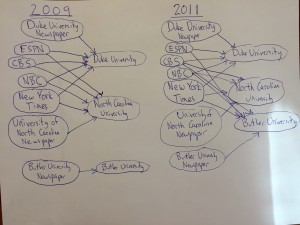Link Analysis Applied to the Flutie Effect
The Flutie Effect references the phenomenon that the success of a university’s athletic program can have positive effects on seemingly unrelated aspects of a school. More specifically, in Devin and Jaren Pope’s study, they test the effect that success of a Division 1 college basketball or football team has on a school’s application statistics. They find that being in the NCAA Basketball Tournament’s field of 64 predicts a 1% increase in the number of applications the following year, the Sweet 16 a 3% increase, the Final 4 a 4%-5% increase, and winning the championship a 7%-8% increase. Similar effects were found in schools who ranked in the AP top 20 college football, and even more so for schools that won the BCS National Championship. Many of these statistics are significant at the 5% level.
The Flutie effect can be examined using Link Analysis, viewing the colleges as authorities and media outlets such as newspapers, websites, and magazines that cover college football and basketball as hubs. As we discussed in class, hubs gain credibility by linking to popular and well-known authorities. For example, in the topic social media, if a hub references links to popular social media outlets such as Facebook, Twitter, Instagram, and Myspace, if there is a fifth link to a less known social media site, one can normally assume that the fifth website has a level of credibility and usefulness. In turn, this fifth website then earns a higher authority score as a result of the link from high scoring hub. This is one way information is filtered and less known websites gain popularity in the presence of an abundance of similar sites.
Now let’s apply this to the Flutie effect. When I was applying to colleges the same abundance existed: the options of schools in the United States was overwhelming and many had similar locations, course offerings, social scenes, and academic prestige. The problem was how to filter these options into 10-12 core colleges that I wished to apply to. One way to do this was to look at college rankings in these attributes. The most credible hubs such as College Board and Princeton Review give schools with the top rankings in these categories higher authority scores by adding network traffic to the schools’ websites. Outstanding performance of a college’s football and basketball teams can have a similar effect. The explanation is straightforward: Media and sports news outlets such as ABC, CBS, NBC, ESPN, New York Times, etc. have the highest hub scores in the college sports network, as they are the sources that both casual and avid sports fans go to for information.
Butler University is a small private university in Indianapolis that few people knew existed before their runs to the NCAA Basketball National Championship in 2010 and 2011. In the process, both explicit (on sports news websites) and implicit (TV exposure, references in newspapers, etc.) links were created from the high scoring hubs previously mentioned to make Butler’s authority score rise drastically. Soon after, Butler University became a more credible university and a household name, seeing its freshmen applications and quality of applicants rise in the following two years. Similar trends were seen in the applicant pools for Wichita State University and George Mason University after their success in the NCAA Basketball Tournament. Seeing as Duke and North Carolina are perennial powerhouses in basketball, the network structure in April (when the NCAA Basketball National Championship takes place) of 2009 vs. 2011 might look something like this:
Thus, Link Analysis applied to the Flutie Effect shows that it can be a powerful tool to analyzing network structures and statistics in topics far different than Internet traffic.
http://faculty.chicagobooth.edu/devin.pope/research/pdf/Website_SEJ%20Sports.pdf
A Cinderella Story: How universities benefit from being an NCAA Tournament underdog

